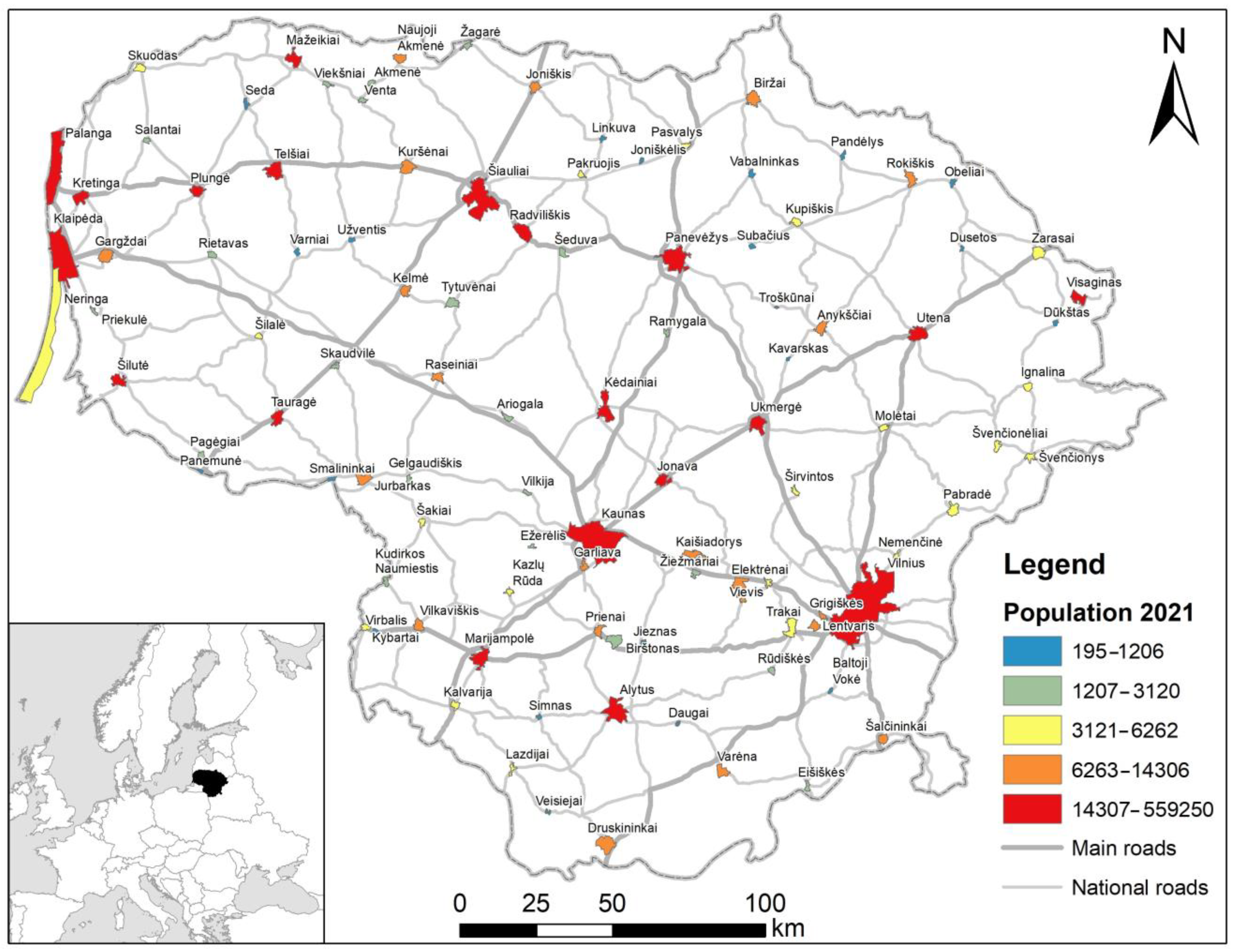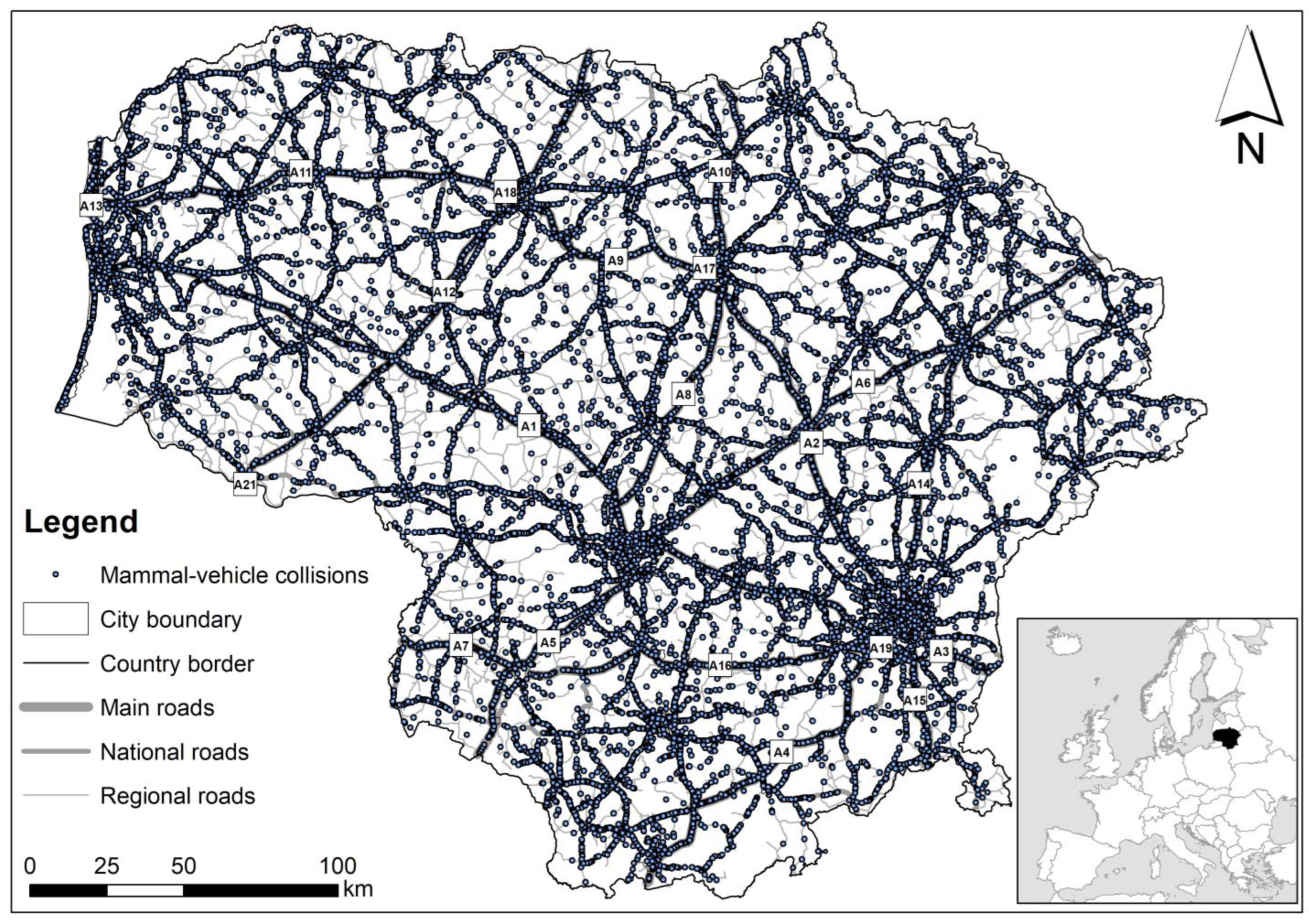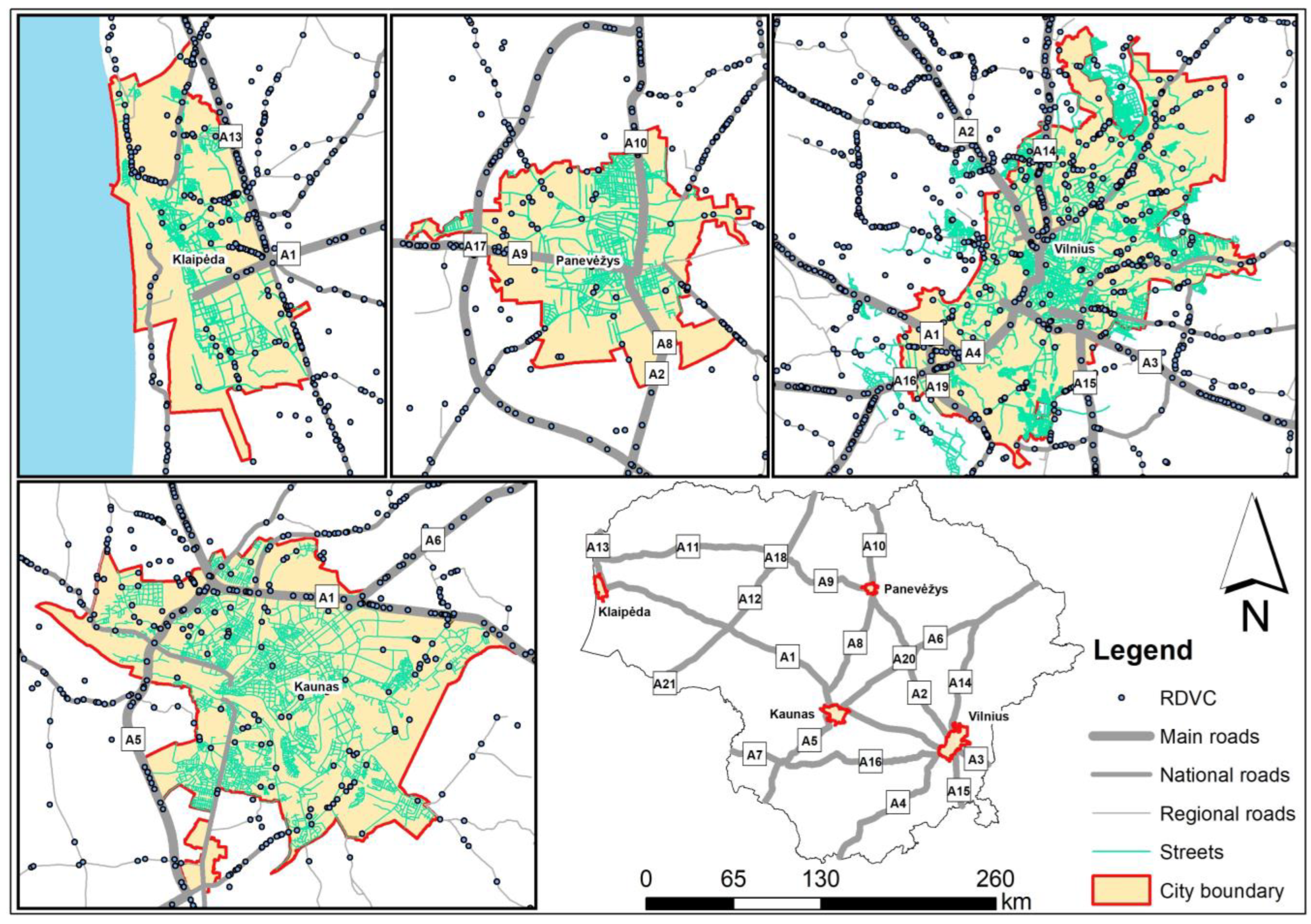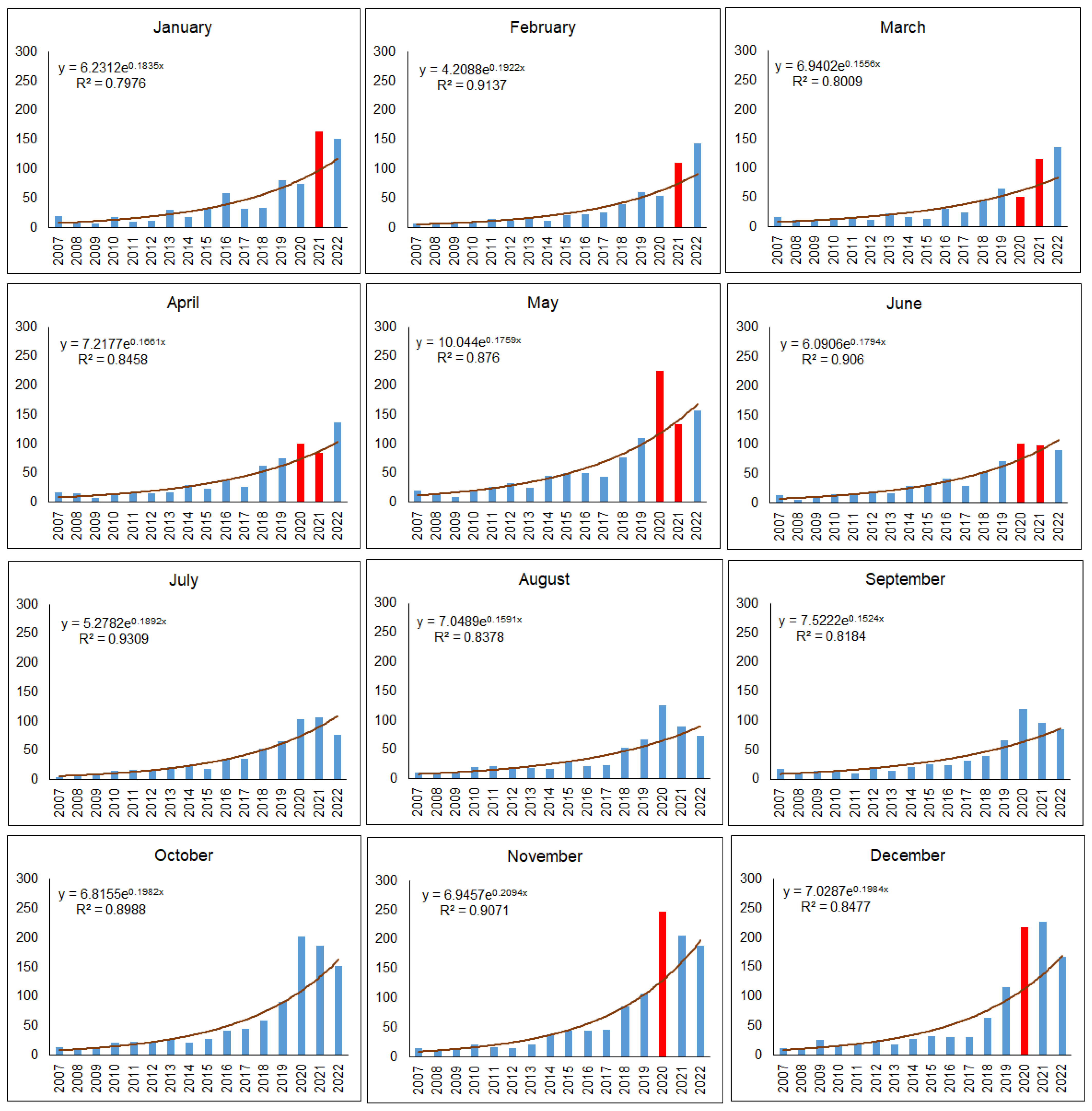Mammal Roadkills in Lithuanian Urban Areas: A 15-Year Study
Abstract
:Simple Summary
Abstract
1. Introduction
2. Materials and Methods
2.1. Study Site

2.2. Roadkill Data
2.3. Lockdown Periods
2.4. Data Analysis
3. Results
3.1. Diversity of Roadkilled Mammals by Road Type, 2007–2022
3.2. Annual Numbers and Diversity of Roadkilled Mammals on Urban Roads, 2007–2022
3.3. Monthly Numbers of Roadkilled Mammals on Urban Roads in the Years of COVID-19 Restrictions
4. Discussion
4.1. Roadkill of Domestic Animals
4.2. Urban Mammals and Roadkills in the Time of COVID-19
4.3. Implications
5. Conclusions
Author Contributions
Funding
Institutional Review Board Statement
Informed Consent Statement
Data Availability Statement
Acknowledgments
Conflicts of Interest
Appendix A


References
- Czech, B.; Krausman, P.R.; Devers, P.K. Economic associations among causes of species endangerment in the United States: Associations among causes of species endangerment in the United States reflect the integration of economic sectors, supporting the theory and evidence that economic growth proceeds at the competitive exclusion of nonhuman species in the aggregate. BioScience 2000, 50, 593–601. [Google Scholar] [CrossRef]
- McKinney, M.L. Urbanization, biodiversity, and conservation: The impacts of urbanization on native species are poorly studied, but educating a highly urbanized human population about these impacts can greatly improve species conservation in all ecosystems. BioScience 2002, 52, 883–890. [Google Scholar] [CrossRef]
- Beninde, J.; Veith, M.; Hochkirch, A. Biodiversity in cities needs space: A meta-analysis of factors determining intra-urban biodiversity variation. Ecol. Lett. 2015, 18, 581–592. [Google Scholar] [CrossRef] [PubMed]
- Clark, T.N.; Lloyd, R.; Wong, K.K.; Jain, P. Amenities drive urban growth. J. Urban Aff. 2002, 24, 493–515. [Google Scholar] [CrossRef]
- Kučas, A. Evaluation of Wildlife—Vehicle Collision Patterns and Assessment of Mitigation Measures. Ph.D. Thesis, Vilnius University, Vilnius, Lithuania, 2021. [Google Scholar]
- Rega-Brodsky, C.C.; Aronson, M.F.; Piana, M.R.; Carpenter, E.S.; Hahs, A.K.; Herrera-Montes, A.; Knapp, S.; Kotze, D.J.; Lepczyk, C.A.; Moretti, M.; et al. Urban biodiversity: State of the science and future directions. Urban Ecosyst. 2022, 25, 1083–1096. [Google Scholar] [CrossRef]
- Knapp, S.; Aronson, M.F.; Carpenter, E.; Herrera-Montes, A.; Jung, K.; Kotze, D.J.; La Sorte, F.A.; Lepczyk, C.A.; MacGregor-Fors, I.; MacIvor, J.S.; et al. A research agenda for urban biodiversity in the global extinction crisis. BioScience 2021, 71, 268–279. [Google Scholar] [CrossRef]
- Perkins, S.E.; Shilling, F.; Collinson, W. Anthropause Opportunities: Experimental Perturbation of Road Traffic and the Potential Effects on Wildlife. Front. Ecol. Evol. 2022, 10, 833129. [Google Scholar] [CrossRef]
- Kowarik, I. Urban wilderness: Supply, demand, and access. Urban For. Urban Green. 2018, 29, 336–347. [Google Scholar] [CrossRef]
- McKinney, M.L.; VerBerkmoes, A. Beneficial health outcomes of natural green infrastructure in cities. Curr. Landsc. Ecol. Rep. 2020, 5, 35–44. [Google Scholar] [CrossRef]
- Spotswood, E.N.; Beller, E.E.; Grossinger, R.; Grenier, J.L.; Heller, N.E.; Aronson, M.F. The biological deserts fallacy: Cities in their landscapes contribute more than we think to regional biodiversity. Bioscience 2021, 71, 148–160. [Google Scholar] [CrossRef]
- Magle, S.B.; Fidino, M.; Sander, H.A.; Rohnke, A.T.; Larson, K.L.; Gallo, T.; Kay, C.A.M.; Lehrer, E.W.; Murray, M.H.; Adalsteinsson, S.A.; et al. Wealth and urbanization shape medium and large terrestrial mammal communities. Glob. Chang. Biol. 2021, 27, 5446–5459. [Google Scholar] [CrossRef]
- Van Helden, B.E.; Close, P.G.; Steven, R. Mammal conservation in a changing world: Can urban gardens play a role? Urban Ecosyst. 2020, 23, 555–567. [Google Scholar] [CrossRef]
- Schnetler, A.K.; Radloff, F.G.; O’Riain, M.J. Medium and large mammal conservation in the City of Cape Town: Factors influencing species richness in urban nature reserves. Urban Ecosyst. 2021, 24, 215–232. [Google Scholar] [CrossRef]
- Ritzel, K.; Gallo, T. Behavior Change in Urban Mammals: A Systematic Review. Front. Ecol. Evol. 2020, 8, 576665. [Google Scholar] [CrossRef]
- Baranauskas, K.; Balčiauskas, L.; Mažeikytė, R. Vilnius city theriofauna. Acta Zool. Litu. 2005, 15, 228–238. [Google Scholar] [CrossRef]
- Balčiauskas, L.; Mažeikytė, R.; Baranauskas, K. Diversity of mammals in the Vilnius city. Acta Biol. Univ. Daugavp. 2005, 5, 55–66. [Google Scholar]
- Hursh, S.H.; Bauder, J.M.; Fidino, M.; Drake, D. An urban cast of characters: Landscape use and cover influencing mammal occupancy in an American midwestern city. Landsc. Urban Plan. 2023, 229, 104582. [Google Scholar] [CrossRef]
- Litvaitis, J.A.; Tash, J.P. An Approach Toward Understanding Wildlife-Vehicle Collisions. Environ. Manag. 2008, 42, 688–697. [Google Scholar] [CrossRef]
- Kent, E.; Schwartz, A.L.; Perkins, S.E. Life in the fast lane: Roadkill risk along an urban–rural gradient. J. Urban Ecol. 2021, 7, juaa039. [Google Scholar] [CrossRef]
- Kreling, S.E.; Gaynor, K.M.; Coon, C.A. Roadkill distribution at the wildland-urban interface. J. Wildl. Manag. 2019, 83, 1427–1436. [Google Scholar] [CrossRef]
- Denneboom, D.; Bar-Massada, A.; Shwartz, A. Wildlife mortality risk posed by high and low traffic roads. Conserv. Biol. 2023. [Google Scholar] [CrossRef]
- Cook, E. Comparing Roadkill Abundance between Urban and Rural Transects. 2022. Available online: https://digitalcommons.humboldt.edu/cgi/viewcontent.cgi?article=1041&context=ideafest2022 (accessed on 1 August 2023).
- Corazza, C.; Finotti, G.; Milioni, F. Urban conglomerates and Vertebrate roadkill on the verge of a Natura 2000 site. Quad. Mus. Civ. Stor. Nat. Ferrara 2021, 9, 139–154. [Google Scholar]
- Takahashi, Y.; Suzuki, F.; Tsuji, Y. Spatio-temporal patterns of vertebrate roadkills in a suburban area in northern Japan. Mammal Res. 2023, 68, 85–92. [Google Scholar] [CrossRef]
- Carvalho-Roel, C.F.; Iannini-Custódio, A.E.; Marçal Júnior, O. Do roadkill aggregations of wild and domestic mammals overlap? Rev. Biol. Trop. 2019, 67, 47–60. [Google Scholar] [CrossRef]
- Lee, S.D. A study of wildlife roadkill in Joongang Highway. Environ. Impact Assess. 2004, 13, 21–31. [Google Scholar]
- Kioko, J.; Kiffner, C.; Jenkins, N.; Collinson, W. Wildlife roadkill patterns on a major highway in northern Tanzania. Afr. Zool. 2015, 50, 17–22. [Google Scholar] [CrossRef]
- Balčiauskas, L.; Stratford, J.; Balčiauskienė, L.; Kučas, A. Importance of professional roadkill data in assessing diversity of mammal roadkills. Transp. Res. D Transp. Environ. 2020, 87, 102493. [Google Scholar] [CrossRef]
- Balčiauskas, L.; Stratford, J.; Kučas, A.; Balčiauskienė, L. Lockdown’s silver lining? Different levels of roadkill during COVID-19 times in Lithuania. Animals 2023, 13, 2918. [Google Scholar] [CrossRef] [PubMed]
- Rastandeh, A.; Jarchow, M. Urbanization and biodiversity loss in the post-COVID-19 era: Complex challenges and possible solutions. Cities Health 2021, 5 (Suppl. 1), S37–S40. [Google Scholar] [CrossRef]
- Vardi, R.; Berger-Tal, O.; Roll, U. iNaturalist insights illuminate COVID-19 effects on large mammals in urban centers. Biol. Conserv. 2021, 254, 10895. [Google Scholar] [CrossRef]
- Zellmer, A.J.; Wood, E.M.; Surasinghe, T.; Putman, B.J.; Pauly, G.B.; Magle, S.B.; Lewis, J.S.; Kay, C.A.M.; Fidino, M. What can we learn from wildlife sightings during the COVID-19 global shutdown? Ecosphere 2020, 11, e03215. [Google Scholar] [CrossRef]
- Rutz, C.; Loretto, M.C.; Bates, A.E.; Davidson, S.C.; Duarte, C.M.; Jetz, W.; Johnson, M.; Kato, A.; Kays, R.; Mueller, T.; et al. COVID-19 lockdown allows researchers to quantify the effects of human activity on wildlife. Nat. Ecol. Evol. 2020, 4, 1156–1159. [Google Scholar] [CrossRef]
- Silva-Rodríguez, E.A.; Gálvez, N.; Swan, G.J.; Cusack, J.J.; Moreira-Arce, D. Urban wildlife in times of COVID-19: What can we infer from novel carnivore records in urban areas? Sci. Total Environ. 2021, 765, 142713. [Google Scholar] [CrossRef] [PubMed]
- Olejarz, A.; Faltusová, M.; Börger, L.; Güldenpfennig, J.; Jarský, V.; Ježek, M.; Mortlock, E.; Silovský, V.; Podgórski, T. Worse sleep and increased energy expenditure yet no movement changes in sub-urban wild boar experiencing an influx of human visitors (anthropulse) during the COVID-19 pandemic. Sci. Total Environ. 2023, 879, 163106. [Google Scholar] [CrossRef] [PubMed]
- Uehara, H.; Nishiyama, W.; Tatsuzawa, S.; Wada, K.; Ida, T.Y.; Yusa, Y. Impacts of the novel coronavirus SARS-CoV-2 on wildlife behaviour via human activities. PLoS ONE 2023, 18, e0285893. [Google Scholar] [CrossRef] [PubMed]
- Tucker, M.A.; Schipper, A.M.; Adams, T.S.; Attias, N.; Avgar, T.; Babic, N.L.; Barker, K.J.; Bastille-Rousseau, G.; Behr, D.M.; Belant, J.L.; et al. Behavioral responses of terrestrial mammals to COVID-19 lockdowns. Science 2023, 380, 1059–1064. [Google Scholar] [CrossRef]
- Antón, S.F. Monitoring roadkill in Spain: A three years survey during pandemic times. Res. Sq. 2023. [Google Scholar] [CrossRef]
- Statistinė Informacija. 2023. Available online: https://lakd.lt/statistine-informacija (accessed on 21 July 2023).
- Eismo Intensyvumas. Available online: https://lakd.lt/eismo-intensyvumas (accessed on 20 August 2023).
- European Environmental Agency. CORINE Land Cover—Copernicus Land Monitoring Service. Available online: https://land.copernicus.eu/pan-european/corine-land-cover (accessed on 22 August 2023).
- State Service for Protected Areas under the Ministry of Environment of Lithuania State Cadastre of Protected Areas of the Republic of Lithuania. Available online: https://www.geoportal.lt/metadata-catalog/catalog/search/resource/details.page?uuid=%7BC60C6ADC-EB4C-5453-F5CC-F91ED3EE0D05%7D (accessed on 8 February 2022).
- Ministry of Agriculture of the Republic of Lithuania Spatial Data Set of Georeference Base Cadastre. Available online: https://www.geoportal.lt/metadata-catalog/catalog/search/resource/details.page?uuid=%7B37DBF864-DE70-66D9-D5B8-61BDB871DD62%7D (accessed on 22 August 2023).
- VĮ Registrų Centras Administrative Boundaries and Addresses. Available online: https://www.geoportal.lt/metadata-catalog/catalog/search/resource/details.page?uuid=%7B02C776BA-B65C-1056-CCA7-669E1096F352%7D (accessed on 22 August 2023).
- Re-Open EU. Available online: https://reopen.europa.eu/en (accessed on 15 July 2023).
- Bates, A.E.; Primack, R.B.; Biggar, B.S.; Bird, T.J.; Clinton, M.E.; Command, R.J.; Richards, C.; Shellard, M.; Geraldi, N.R.; Vergara, V.; et al. Global COVID-19 lockdown highlights humans as both threats and custodians of the environment. Biol. Conserv. 2021, 263, 109175. [Google Scholar] [CrossRef]
- Krebs, C.J. Ecological Methodology, 2nd ed.; Addison-Wesley Educational Publishers, Inc.: Menlo Park, CA, USA, 1999; 620p. [Google Scholar]
- Hammer, Ø.; Harper, D.A.T.; Ryan, P.D. AST: Paleontological Statistics Software Package for Education and Data Analysis. Palaeontol. Electron. 2001, 4, 9. [Google Scholar]
- Past 4—The Past of the Future. Available online: https://www.nhm.uio.no/english/research/resources/past/ (accessed on 1 July 2023).
- Sawilowsky, S.S. New effect size rules of thumb. J. Mod. Appl. Stat. Methods 2009, 8, 597–599. [Google Scholar] [CrossRef]
- Abramson, J.H. WINPEPI updated: Computer programs for epidemiologists, and their teaching potential. Epidemiol. Perspect. Innov. 2011, 8, 1. [Google Scholar] [CrossRef]
- Zotos, S.; Vogiatzakis, I.N. CyROS: Towards a common methodological framework for roadkills recording in Cyprus. Ecol. Mediterr. 2018, 44, 109–114. [Google Scholar] [CrossRef]
- Périquet, S.; Roxburgh, L.; Le Roux, A.; Collinson, W.J. Testing the value of citizen science for roadkill studies: A case study from South Africa. Front. Ecol. Evol. 2018, 6, 15. [Google Scholar] [CrossRef]
- Wilkins, D.C.; Kockelman, K.M.; Jiang, N. Animal-vehicle collisions in Texas: How to protect travelers and animals on roadways. Accid. Anal. Prev. 2019, 131, 157–170. [Google Scholar] [CrossRef]
- Canal, D.; Martín, B.; De Lucas, M.; Ferrer, M. Dogs are the main species involved in animal-vehicle collisions in southern Spain: Daily, seasonal and spatial analyses of collisions. PLoS ONE 2018, 13, e0203693. [Google Scholar] [CrossRef] [PubMed]
- Mohanty, C.R.; Radhakrishnan, R.V.; Jain, M.; Sasmal, P.K.; Hansda, U.; Vuppala, S.K.; Doki, S.K. A study of the pattern of injuries sustained from road traffic accidents caused by impact with stray animals. J. Emergencies Trauma Shock. 2021, 14, 23–27. [Google Scholar]
- Bíl, M.; Kubeček, J.; Sedoník, J.; Andrášik, R. Srazenazver.cz: A system for evidence of animal-vehicle collisions along transportation networks. Biol. Conserv. 2017, 213, 167–174. [Google Scholar] [CrossRef]
- Asari, Y. Decreased traffic volume during COVID-19 did not reduce roadkill on fenced highway network in Japan. Landsc. Ecol. Eng. 2022, 18, 121–124. [Google Scholar] [CrossRef]
- Caro, T.M.; Shargel, J.A.; Stoner, C.J. Frequency of medium-sized mammal road kills in an agricultural landscape in California. Am. Midl. Nat. 2000, 144, 362–369. [Google Scholar] [CrossRef]
- Brockie, R.E.; Sadleir, R.M.; Linklater, W.L. Long-term wildlife road-kill counts in New Zealand. N. Z. J. Zool. 2009, 36, 123–134. [Google Scholar] [CrossRef]
- Sadleir, R.M.; Linklater, W.L. Annual and seasonal patterns in wildlife road-kill and their relationship with traffic density. N. Z. J. Zool. 2016, 43, 275–291. [Google Scholar] [CrossRef]
- Santos, R.A.L.; Santos, S.M.; Santos-Reis, M.; Picanço de Figueiredo, A.; Bager, A.; Aguiar, L.M.; Ascensao, F. Carcass persistence and detectability: Reducing the uncertainty surrounding wildlife-vehicle collision surveys. PLoS ONE 2016, 11, e0165608. [Google Scholar] [CrossRef] [PubMed]
- Borza, S.; Godó, L.; Valkó, O.; Végvári, Z.; Deák, B. Better safe than sorry–Understanding the attitude and habits of drivers can help mitigating animal-vehicle collisions. J. Environ. Manag. 2023, 339, 117917. [Google Scholar] [CrossRef]
- Norshaqinah, A.; Muzneena, A.; Juliana, S.; Norhayati, A. Drivers’ perception and attitude towards wildlife-vehicle collisions in Langkawi Island, Kedah, Malaysia. Malay. Nat. J. 2023, 75, 341–351. [Google Scholar]
- Tejera, G.; Rodríguez, B.; Armas, C.; Rodríguez, A. Wildlife-vehicle collisions in Lanzarote biosphere reserve, Canary Islands. PLoS ONE 2018, 13, e0192731. [Google Scholar] [CrossRef]
- Pokorny, B.; Cerri, J.; Bužan, E. Wildlife roadkill and COVID-19: A biologically significant, but heterogeneous, reduction. J. Appl. Ecol. 2022, 59, 1291–1301. [Google Scholar] [CrossRef]
- Basak, S.M.; O’Mahony, D.T.; Lesiak, M.; Basak, A.K.; Ziółkowska, E.; Kaim, D.; Hossain, M.S.; Wierzbowska, I.A. Animal-vehicle collisions during the COVID-19 lockdown in early 2020 in the Krakow metropolitan region, Poland. Sci. Rep. 2022, 12, 7572. [Google Scholar] [CrossRef] [PubMed]
- Abraham, J.O.; Mumma, M.A. Elevated wildlife-vehicle collision rates during the COVID-19 pandemic. Sci. Rep. 2021, 11, 20391. [Google Scholar] [CrossRef] [PubMed]
- Balčiauskas, L.; Balčiauskienė, L.; Litvaitis, J.A.; Tijušas, E. Adaptive monitoring: Using citizen scientists to track wolf populations when winter-track counts become unreliable. Wildl. Res. 2020, 48, 76–85. [Google Scholar] [CrossRef]
- Coman, I.A.; Cooper-Norris, C.E.; Longing, S.; Perry, G. It is a wild world in the city: Urban wildlife conservation and communication in the age of COVID-19. Diversity 2022, 14, 539. [Google Scholar] [CrossRef]
- Hadad, E.; Kosicki, J.Z.; Yosef, R. Spatial modeling of road collisions of striped hyena (Hyaena hyaena) in Israel. Ecol. Res. 2023. [Google Scholar] [CrossRef]
- Bressler, S.A.; Diamant, E.S.; Cen, C.; Yeh, P.J. Phenotypic plasticity in the anthropause: Does reduced human activity impact novel nesting behaviour in an urban bird? Anim. Behav. 2023, 203, 143–155. [Google Scholar] [CrossRef]
- Hockenhull, J.; Squibb, K.; Cameron, A. How has the COVID-19 pandemic affected the way we access and interact with the countryside and the animals within it? Animals 2021, 11, 2281. [Google Scholar] [CrossRef]
- Kleinschroth, F.; Kowarik, I. COVID-19 crisis demonstrates the urgent need for urban greenspaces. Front. Ecol. Environ. 2020, 18, 318. [Google Scholar] [CrossRef] [PubMed]
- Ellis-Soto, D.; Oliver, R.Y.; Brum-Bastos, V.; Demšar, U.; Jesmer, B.; Long, J.A.; Cagnacci, F.; Ossi, F.; Queiroz, N.; Hindell, M.; et al. A vision for incorporating human mobility in the study of human–wildlife interactions. Nat. Ecol. Evol. 2023, 7, 1362–1372. [Google Scholar] [CrossRef]
- Kolandai, K.; Milne, B.; McLay, J.; von Randow, M.; Lay-Yee, R. Anthropause appreciation, biophilia, and ecophilosophical contemplations amidst a global pandemic. J. Environ. Psychol. 2023, 85, 101943. [Google Scholar] [CrossRef]
- Grilo, C.; Borda-de-Água, L.; Beja, P.; Goolsby, E.; Soanes, K.; le Roux, A.; Koroleva, E.; Flávio, Z.; Ferreira, F.Z.; Gagné, S.A.; et al. Conservation threats from roadkill in the global road network. Glob. Ecol. Biogeogr. 2021, 30, 2200–2210. [Google Scholar] [CrossRef]
- Balčiauskas, L.; Kučas, A.; Balčiauskienė, L. The Impact of Roadkill on Cervid Populations in Lithuania. Forests 2023, 14, 1224. [Google Scholar] [CrossRef]
- Xie, L.; Bulkeley, H. Nature-based solutions for urban biodiversity governance. Environ. Sci. Policy 2020, 110, 77–87. [Google Scholar] [CrossRef]
- Swinnen, K.R.; Jacobs, A.; Claus, K.; Ruyts, S.; Vercayie, D.; Lambrechts, J.; Herremans, M. ‘Animals under wheels’: Wildlife roadkill data collection by citizen scientists as a part of their nature recording activities. Nat. Conserv. 2022, 47, 121–153. [Google Scholar] [CrossRef]







| Species | Total | Urban, n (%) | Main, n (%) | National, n (%) | Regional, n (%) |
|---|---|---|---|---|---|
| Domestic Mammals | |||||
| Horse (Equus ferus caballus) | 155 | 59 (38.1) | 21 (13.5) | 52 (33.5) | 23 (14.8) |
| Cattle (Bos taurus) | 305 | 69 (22.6) | 53 (17.4) | 122 (40.0) | 61 (20.0) |
| Goat (Capra aegagrus hircus) | 10 | 4 (40.0) | 1 (10.0) | 2 (20.0) | 3 (30.0) |
| Sheep (Ovis aries) | 44 | 17 (38.6) | 7 (15.9) | 11 (25.0) | 9 (20.5) |
| Pig (Sus scrofa domesticus) | 2 | 1 (50.0) | 1 (50.0) | ||
| Rabbit (Oryctolagus cuniculus) | 5 | 2 (40.0) | 1 (20.0) | 1 (20.0) | 1 (20.0) |
| Dog (Canis familiaris) | 1858 | 921 (49.6) | 345 (18.6) | 396 (21.3) | 196 (10.5) |
| Cat (Felis catus) | 207 | 49 (23.7) | 94 (45.4) | 49 (23.7) | 15 (7.2) |
| Wild Mammals | |||||
| European bison (Bison bonasus) | 9 | 8 (88.9) | 1 (11.1) | ||
| Moose (Alces alces) | 2589 | 366 (14.1) | 1017 (39.3) | 943 (36.4) | 263 (10.2) |
| Red deer (Cervus elaphus) | 713 | 83 (11.6) | 244 (34.2) | 307 (43.1) | 79 (11.1) |
| Wild boar (Sus scrofa) | 1962 | 245 (12.5) | 642 (32.7) | 746 (38.0) | 329 (16.8) |
| Fallow deer (Dama dama) | 50 | 3 (6.0) | 10 (20.0) | 31 (62.0) | 6 (12.0) |
| Roe deer (Capreolus capreolus) | 28,024 | 6303 (22.5) | 5316 (19.0) | 11,433 (40.8) | 4972 (17.7) |
| Gray wolf (Canis lupus) | 29 | 7 (24.1) | 15 (51.7) | 5 (17.2) | 2 (6.9) |
| Lynx (Lynx lynx) | 7 | 3 (42.8) | 2 (28.6) | 2 (28.6) | |
| Badger (Meles meles) | 243 | 21 (8.6) | 102 (42.0) | 80 (32.9) | 40 (16.5) |
| Red fox (Vulpes vulpes) | 1214 | 81 (6.7) | 805 (66.3) | 260 (21.4) | 68 (5.6) |
| Raccoon dog (Nyctereutes procyonoides) | 1678 | 21 (1.3) | 1305 (77.8) | 294 (17.5) | 58 (3.5) |
| Raccoon (Procyon lotor) | 10 | 10 (100.0) | |||
| Eurasian otter (Lutra lutra) | 22 | 17 (77.3) | 4 (18.2) | 1 (4.5) | |
| Marten (Martes sp.) | 414 | 1 (0.2) | 370 (89.4) | 41 (9.9) | 2 (0.5) |
| Pine marten (Martes martes) | 70 | 56 (80.0) | 14 (20.0) | ||
| Stone marten (Martes foina) | 35 | 23 (65.7) | 10 (28.6) | 2 (5.7) | |
| European polecat (Mustela putorius) | 188 | 5 (2.7) | 153 (81.4) | 30 (16.0) | |
| American mink (Neovison vison) | 26 | 26 (100.0) | |||
| Least weasel (Mustela nivalis) | 2 | 2 (100.0) | |||
| Stoat (Mustela erminea) | 2 | 1 (50.0) | 1 (50.0) | ||
| European hare (Lepus europaeus) | 691 | 87 (12.6) | 235 (34.0) | 242 (35.0) | 127 (18.4) |
| Mountain hare (Lepus timidus) | 1 | 1 (100.0) | |||
| Beaver (Castor fiber) | 65 | 16 (24.6) | 26 (40.0) | 17 (26.2) | 6 (9.2) |
| Muskrat (Ondatra zibethicus) | 2 | 2 (100.0) | |||
| Red squirrel (Sciurus vulgaris) | 40 | 34 (85.0) | 6 (15.0) | ||
| Norway rat (Rattus norvegicus) | 10 | 5 (50.0) | 4 (40.0) | 1 (10.0) | |
| Black rat (Rattus rattus) | 1 | 1 (100.0) | |||
| Yellow-necked mouse (Apodemus flavicollis) | 2 | 2 (100.0) | |||
| Bank vole (Clethrionomys glareolus) | 3 | 3 (100.0) | |||
| Eastern hedgehog (Erinaceus concolor) | 1158 | 8 (0.7) | 953 (82.3) | 182 (15.7) | 15 (1.3) |
| European mole (Talpa europaea) | 20 | 11 (55.0) | 7 (35.0) | 2 (10.0) | |
| Water shrew (Neomys fodiens) | 1 | 1 (100.0) | |||
| Common shrew (Sorex araneus) | 2 | 2 (100.0) | |||
| Unknown | 5685 | 823 (14.5) | 1836 (32.3) | 2200 (38.7) | 826 (14.5) |
| Index | Total | Urban | Main | National | Regional |
|---|---|---|---|---|---|
| Number of Individuals, n | 47,554 | 9192 | 13,736 | 17,516 | 7110 |
| Number of Species, S | 40 | 21 a | 35 b | 33 b | 25 a |
| Dominance, D | 0.47 | 0.58 b | 0.25 c | 0.57 b | 0.63 a |
| Diversity, Shannon’s H | 1.41 | 1.02 a | 1.95 b | 1.16 c | 0.98 a |
Disclaimer/Publisher’s Note: The statements, opinions and data contained in all publications are solely those of the individual author(s) and contributor(s) and not of MDPI and/or the editor(s). MDPI and/or the editor(s) disclaim responsibility for any injury to people or property resulting from any ideas, methods, instructions or products referred to in the content. |
© 2023 by the authors. Licensee MDPI, Basel, Switzerland. This article is an open access article distributed under the terms and conditions of the Creative Commons Attribution (CC BY) license (https://creativecommons.org/licenses/by/4.0/).
Share and Cite
Balčiauskas, L.; Kučas, A.; Balčiauskienė, L. Mammal Roadkills in Lithuanian Urban Areas: A 15-Year Study. Animals 2023, 13, 3272. https://doi.org/10.3390/ani13203272
Balčiauskas L, Kučas A, Balčiauskienė L. Mammal Roadkills in Lithuanian Urban Areas: A 15-Year Study. Animals. 2023; 13(20):3272. https://doi.org/10.3390/ani13203272
Chicago/Turabian StyleBalčiauskas, Linas, Andrius Kučas, and Laima Balčiauskienė. 2023. "Mammal Roadkills in Lithuanian Urban Areas: A 15-Year Study" Animals 13, no. 20: 3272. https://doi.org/10.3390/ani13203272








